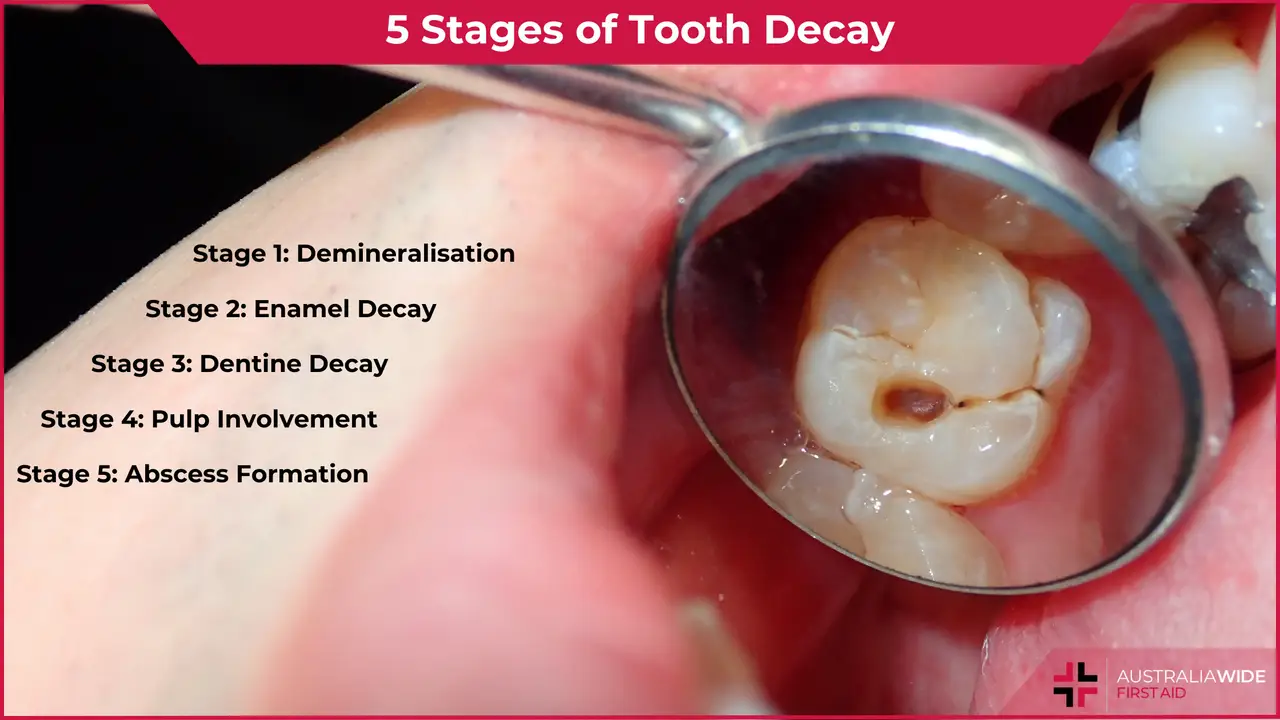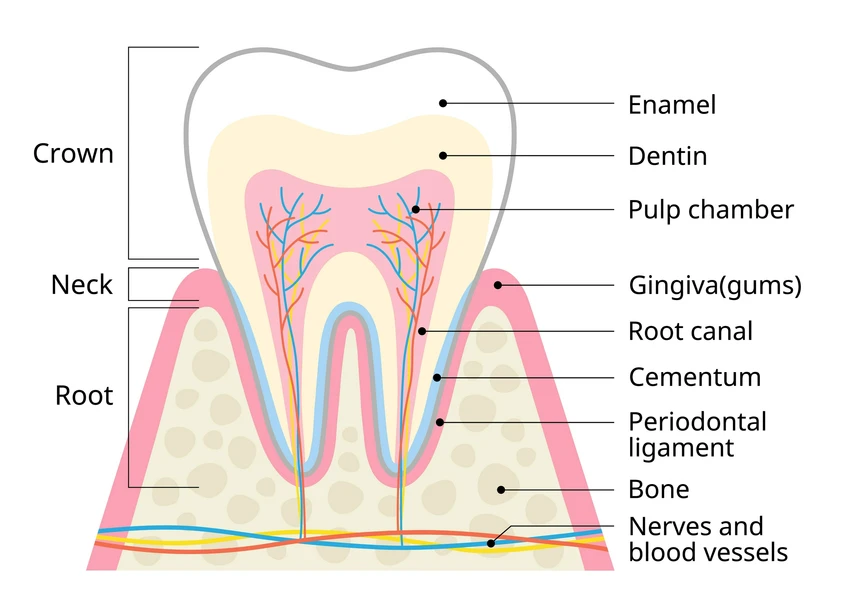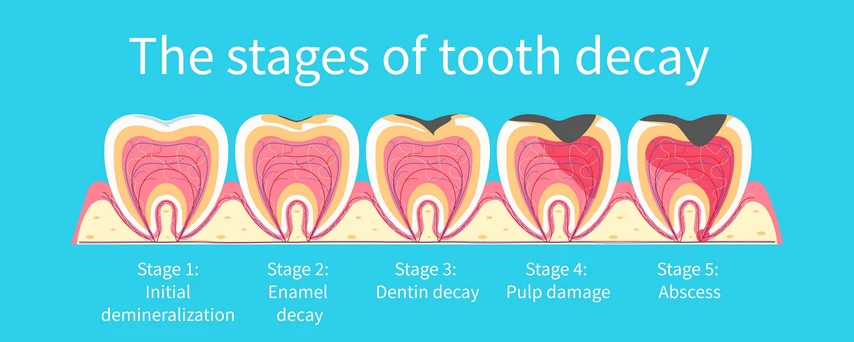Exploring the 5 Stages of Tooth Decay and Their Treatment


Maintaining optimal oral health is vital for a confident smile and overall well-being. One of the most common dental problems around the globe is dental caries, commonly referred to as dental cavities or tooth decay. Dental cavities caught early are relatively easy to treat and less invasive for the patient.
Unfortunately, many patients report to the dental clinic with advanced dental caries that require invasive procedures such as root canal treatment or extraction for proper treatment.
The purpose of this article is to empower you with information to ensure you reach your dentist in time and get the proper treatment necessary. We will delve into the five stages of tooth decay, when to visit a dentist and available treatment options.

Before we begin with the stages, it is important to reflect on the basic structure of the tooth.
Our teeth consist of three layers namely: enamel, dentine and dental pulp.
The enamel is the outermost, highly mineralised and protective layer that covers the crown of the tooth. This layer helps resist bacterial attacks and prevents the infectious agents from reaching the pulp.
Similar to enamel in the crown, we have cementum in the tooth root; it is comparatively less mineralised.
Beneath the enamel and cementum is the dentine, which is less mineralised and gives your tooth its colour.
The innermost layer is the dental pulp, which consists of connective tissue, nerves and blood vessels.
Let's discuss the stages of tooth decay now that we understand tooth structure.

The earliest stage of tooth decay is demineralisation.
Our mouth hosts millions of bacteria and other microbes. While some of these are harmless and even beneficial, some can be disease-causing under the right circumstances.
The disease-causing bacteria metabolise the sugars from the food we eat and release acidic by-products. This acid attacks the enamel and leads to the process of demineralisation (enamel begins to lose its minerals).
During this stage, you won't see any visible indicators of tooth damage. The area of the tooth that has undergone demineralisation will appear frosted white and there is no associated pain. Therefore, this stage often gets missed.
Treatment: This stage of tooth decay is reversible with proper care. Using fluoride toothpaste and maintaining good oral health can facilitate enamel remineralisation.
The best way to manage tooth decay at this stage is to go to your dentist for professional fluoride treatment. This is also why it is recommended that you visit a dentist once every 6 months even if you don't have any complaints.
Your doctor can spot these areas of demineralisation and advise proper treatment.
A diet adjustment such as reducing the intake of sugary and acidic foods, can also aid in preventing demineralisation.
In the second stage, the process of demineralisation continues. The enamel becomes weak. It becomes easier for the bacteria to travel forward and continue damaging the tooth.
This leads to the formation of small cavities or holes in the enamel that may appear yellowish-brown. These cavities are typically painless.
Treatment: Dental fillings are the usual course of action to repair these initial cavities. Maintaining good oral hygiene practices remains essential to thwart further decay and cavity development.
If left untreated, tooth decay progresses to the dentine. At this point, you may experience heightened sensitivity and mild discomfort when consuming hot, cold, sweet, or acidic foods and beverages.
The cavity becomes a little deeper and may appear dark brown.
Treatment: Dental fillings and protective treatments such as pulp capping are commonly recommended by dentists to address decay that has extended into the dentin.
In severe cases, a dental crown may be necessary to reinstate the tooth's strength and shape. Maintaining a rigorous oral hygiene routine is pivotal to preventing further deterioration.
As tooth decay advances, it will eventually reach the pulp. This stage is marked by intense pain, increased sensitivity, and the potential for subsequent infections such as abscesses.
Treatment: The typical treatment for pulp involvement is a root canal procedure, which entails the removal of the infected or damaged pulp while preserving the tooth's structure.
Following the pulp's removal, a dental crown is often applied to fortify and safeguard the tooth.
In the most advanced stage of tooth decay, an abscess (pus-filled cavity) may develop along the root end of the tooth. Abscess leads to debilitating pain and swelling.
Treatment: Addressing an abscess may necessitate a combination of treatments, including a root canal, abscess drainage, and antibiotic therapy.
In cases where the tooth is beyond saving, tooth removal remains the only option.
Familiarising oneself with the five stages of tooth decay is crucial for maintaining good oral health.
Regular dental check-ups, diligent oral hygiene practices, and a wholesome diet are essential in preventing and treating tooth decay, especially in its early stages.
Should you suspect the presence of tooth decay, it is advisable to consult with your dentist without delay.

March 25, 2025
Explore non-traditional paths to sobriety, including mindfulness, yoga, nutritional therapy, and community-based support, for a personalized approach to recovery.

September 7, 2022
Menopause is the final period, when a woman, trans man, or non-binary person assigned female at birth's ovaries run out of eggs and the body can no longer ovulate. Menopause comes with several symptoms, complications, and treatment options.

July 26, 2024
Transcutaneous Electrical Nerve Stimulation (TENS) is a therapeutic method of pain relief. It utilises an electrical device that emits electrical currents and streams the impulses via electrode patches attached to the skin.